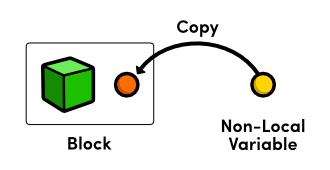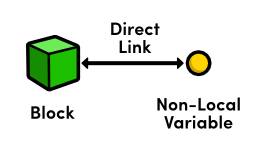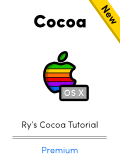You’re reading Ry’s Objective-C Tutorial |
Blocks
Blocks are Objective-C’s anonymous functions. They let you pass arbitrary statements between objects as you would data, which is often more intuitive than referencing functions defined elsewhere. In addition, blocks are implemented as closures, making it trivial to capture the surrounding state.
Creating Blocks
Blocks use all the same mechanics as normal functions. You can declare a block variable just like you would declare a function, define the block as though you would implement a function, and then call the block as if it were a function:
// main.m#import<Foundation/Foundation.h>intmain(intargc,constchar*argv[]){@autoreleasepool{// Declare the block variabledouble(^distanceFromRateAndTime)(doublerate,doubletime);// Create and assign the blockdistanceFromRateAndTime=^double(doublerate,doubletime){returnrate*time;};// Call the blockdoubledx=distanceFromRateAndTime(35,1.5);NSLog(@"A car driving 35 mph will travel "@"%.2f miles in 1.5 hours.",dx);}return0;}
The caret (^) is used to mark the
distanceFromRateAndTime variable as a block. Like a function
declaration, you need to include the return type and parameter types so the
compiler can enforce type safety. The ^ behaves in a similar
manner to the asterisk before a pointer (e.g., int *aPointer) in
that it is only required when declaring the block, after which you can
use it like a normal variable.
The block itself is essentially a function definition—without the
function name. The ^double(double rate, double time) signature
begins a block literal that returns a double and has two
parameters that are also doubles (the return type can be omitted if desired).
Arbitrary statements can go inside the curly braces ({}), just
like a normal function.
After assigning the block literal to the
distanceFromRateAndTime variable, we can call that
variable as though it were a function.
Parameterless Blocks
If a block doesn’t take any parameters, you can omit the argument list
in its entirety. And again, specifying the return type of a block literal is
always optional, so you can shorten the notation to ^ { ... }:
double(^randomPercent)(void)=^{return(double)arc4random()/4294967295;};NSLog(@"Gas tank is %.1f%% full",randomPercent()*100);
The built-in arc4random()
function returns a random 32-bit integer. By dividing by the maximum possible
value of arc4random() (4294967295), we get a decimal
value between 0 and 1.
So far, it might seem like blocks are just a complicated way of defining functions. But, the fact that they’re implemented as closures opens the door to exciting new programming opportunities.
Closures
Inside of a block, you have access to same data as in a normal function:
local variables, parameters passed to the block, and global
variables/functions. But, blocks are implemented as closures,
which means that you also have access to non-local variables.
Non-local variables are variables defined in the block’s enclosing
lexical scope, but outside the block itself. For example,
getFullCarName can reference the make variable
defined before the block:
NSString*make=@"Honda";NSString*(^getFullCarName)(NSString*)=^(NSString*model){return[makestringByAppendingFormat:@" %@",model];};NSLog(@"%@",getFullCarName(@"Accord"));// Honda Accord
Non-local variables are copied and stored with the block as
const variables, which means they are read-only. Trying to assign
a new value to the make variable from inside the block will throw
a compiler error.

const
copiesThe fact that non-local variables are copied as constants means that a block
doesn’t just have access to non-local variables—it creates
a snapshot of them. Non-local variables are frozen at whatever value
they contain when the block is defined, and the block always uses that
value, even if the non-local variable changes later on in the program. Watch
what happens when we try to change the make variable after
creating the block:
NSString*make=@"Honda";NSString*(^getFullCarName)(NSString*)=^(NSString*model){return[makestringByAppendingFormat:@" %@",model];};NSLog(@"%@",getFullCarName(@"Accord"));// Honda Accord// Try changing the non-local variable (it won't change the block)make=@"Porsche";NSLog(@"%@",getFullCarName(@"911 Turbo"));// Honda 911 Turbo
Closures are an incredibly convenient way to work with the surrounding state, as it eliminates the need to pass in extra values as parameters—you simply use non-local variables as if they were defined in the block itself.
Mutable Non-Local Variables
Freezing non-local variables as constant values is a safe default behavior
in that it prevents you from accidentally changing them from within the block;
however, there are occasions when this is desirable. You can override the
const copy behavior by declaring a non-local variable with the
__block storage modifier:
__blockNSString*make=@"Honda";
This tells the block to capture the variable by reference, creating
a direct link between the make variable outside the block and the
one inside the block. You can now assign a new value to make from
outside the block, and it will be reflected in the block, and vice versa.

Like static
local variables in normal functions, the __block modifier
serves as a “memory” between multiple calls to a block. This makes
it possible to use blocks as generators. For example, the following snippet
creates a block that “remembers” the value of i over
subsequent invocations.
__blockinti=0;int(^count)(void)=^{i+=1;returni;};NSLog(@"%d",count());// 1NSLog(@"%d",count());// 2NSLog(@"%d",count());// 3
Blocks as Method Parameters
Storing blocks in variables is occasionally useful, but in the real world, they’re more likely to be used as method parameters. They solve the same problem as function pointers, but the fact that they can be defined inline makes the resulting code much easier to read.
For example, the following Car interface declares a method that
tallies the distance traveled by the car. Instead of forcing the caller to pass
a constant speed, it accepts a block that defines the car’s speed as a
function of time.
// Car.h#import<Foundation/Foundation.h>@interfaceCar:NSObject@propertydoubleodometer;-(void)driveForDuration:(double)durationwithVariableSpeed:(double(^)(doubletime))speedFunctionsteps:(int)numSteps;@end
The data type for the block is double (^)(double time), which
states that whatever block the caller passes to the method should return a
double and accept a single double parameter. Note
that this is almost the exact same syntax as the block variable declaration
discussed at the beginning of this module, but without the variable name.
The implementation can then call the block via speedFunction.
The following example uses a naïve right-handed Riemann sum to approximate
the distance traveled over duration. The steps
argument is used to let the caller determine the precision of the estimate.
// Car.m#import"Car.h"@implementationCar@synthesizeodometer=_odometer;-(void)driveForDuration:(double)durationwithVariableSpeed:(double(^)(doubletime))speedFunctionsteps:(int)numSteps{doubledt=duration/numSteps;for(inti=1;i<=numSteps;i++){_odometer+=speedFunction(i*dt)*dt;}}@end
As you can see in the main() function included below, block
literals can be defined within a method invocation. While it might
take a second to parse the syntax, this is still much more intuitive than
creating a dedicated top-level function to define the
withVariableSpeed parameter.
// main.m#import<Foundation/Foundation.h>#import"Car.h"intmain(intargc,constchar*argv[]){@autoreleasepool{Car*theCar=[[Caralloc]init];// Drive for awhile with constant speed of 5.0 m/s[theCardriveForDuration:10.0withVariableSpeed:^(doubletime){return5.0;}steps:100];NSLog(@"The car has now driven %.2f meters",theCar.odometer);// Start accelerating at a rate of 1.0 m/s^2[theCardriveForDuration:10.0withVariableSpeed:^(doubletime){returntime+5.0;}steps:100];NSLog(@"The car has now driven %.2f meters",theCar.odometer);}return0;}
This is a simple example of the versatility of blocks, but the standard
frameworks are chock-full of other use cases. NSArray
lets you sort elements with a block via the
sortedArrayUsingComparator: method, and UIView
uses a block to define the final state of an animation via the
animateWithDuration:animations: method.
In addition, the NSOpenPanel
class executes a block after the user selects a file. This convenient behavior
is explored in the Persistent Data
chapter of Ry’s Cocoa
Tutorial.
Defining Block Types
Since the syntax for block data types can quickly clutter up your method
declarations, it’s often useful to typedef common block
signatures. For instance, the following code creates a new type called
SpeedFunction that we can use as a more semantic data type for the
withVariableSpeed argument.
// Car.h#import<Foundation/Foundation.h>// Define a new type for the blocktypedefdouble(^SpeedFunction)(double);@interfaceCar:NSObject@propertydoubleodometer;-(void)driveForDuration:(double)durationwithVariableSpeed:(SpeedFunction)speedFunctionsteps:(int)numSteps;@end
Many of the standard Objective-C frameworks also use this technique (e.g.,
NSComparator).
Summary
Blocks provide much the same functionality as C functions, but they are much more intuitive to work with (after you get used to the syntax). The fact that they can be defined inline makes it easy to use them inside of method calls, and since they are closures, it’s possible to capture the value of surrounding variables with literally no additional effort.
The next module switches gears a little bit and delves into iOS’s and
OS X’s error-handling capabilities. We’ll explore two
important classes for representing errors: NSException and
NSError.
 |
Be sure to check out Ry’s Cocoa Tutorial. This brand new guide is a complete walkthrough of Mac App development, and it leverages all of the Objective-C skills that we just discussed. Learn more › |
Mailing List
Sign up for my low-volume mailing list to find out when new content is released. Next up is a comprehensive Swift tutorial planned for late January.
You’ll only receive emails when new tutorials are released, and your contact information will never be shared with third parties. Click here to unsubscribe.